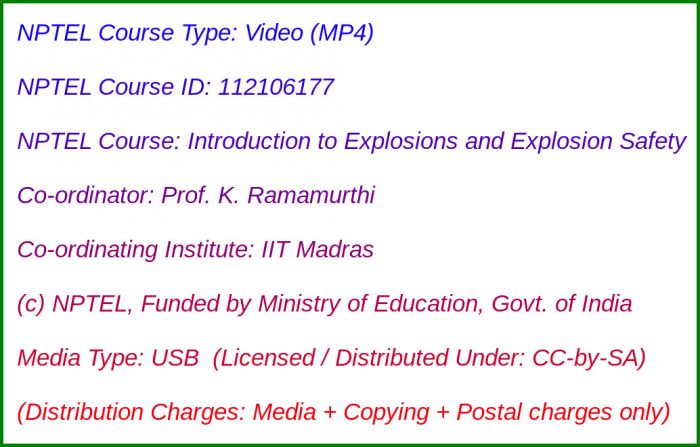Introduction to Explosions and Explosion Safety (USB)

Media Storage Type : 64 GB USB Stick
NPTEL Subject Matter Expert : Prof. K. Ramamurthi
NPTEL Co-ordinating Institute : IIT Madras
NPTEL Lecture Count : 40
NPTEL Course Size : 33 GB
NPTEL PDF Text Transcription : Available and Included
NPTEL Subtitle Transcription : Available and Included (SRT)
Lecture Titles:
Lecture 1 - Loud Bang and Disruption
Lecture 2 - Blast Wave in an Explosion: Predictions from Dimensional Considerations
Lecture 3 - Typical Examples of Explosions and Classification
Lecture 4 - Shock Hugoniot and Rayleigh Line
Lecture 5 - Properties behind a Constant Velocity Shock
Lecture 6 - Blast waves:Concentration of Mass at the Front,Snow Plow Approximation,Energy conservation ina Blast wave
Lecture 7 - Blast waves: Decay of a strong Blast wave,Explosion Length, Sach's Scaling,Over pressure,Cranz Hopkinson Scaling law of Overpressure
Lecture 8 - Blast Waves: Overpressure and Impulse in the Near and Far Field, Examples,Introduction to Impulse
Lecture 9 - Blast Waves: Non-dimensional Impulse, Cranz -Hopkinson Scaling, Missiles, Fragments and Shrapnel, Craters, Examples
Lecture 10 - Blast Waves: Interaction with Objects, Reflection and Transmission of Blast Waves, Impedance
Lecture 11 - Blast Waves: Amplification of Reflected Blast Waves; Role of Impedance, Spalling, Damage to Organs containing Air, Mushroom Cloud in an Explosion, Examples
Lecture 12 - Blast Waves: Damage from Blast Waves, Examples, Multiple Spikes in an Impulse, Iso-damage Curve on an Overpressure- Impulse Diagram, Complex Structures
Lecture 13 - Energy Release in a Chemical Reaction: Moles, Internal Chemical Energy, Standard Heats of Formation
Lecture 14 - Energy Release: Stoichiometry, Equivalence Ratio and Heat Release in Fuel Rich and Oxidizer Rich Compounds
Lecture 15 - Energy Release: Examples of Energy Release Calculations, Higher and Lower Calorific Values, Internal Energy of Formation
Lecture 16 - Rate of Energy Release: Concentration, Activation Energy, Energy Release Profile
Lecture 17 - Thermal Theory of Explosion
Lecture 18 - Thermal Theory
Lecture 19 - Role of Chain Carriers in an Explosion
Lecture 20 - Combustion - I
Lecture 21 - Combustion - II
Lecture 22 - Case Histories of Explosions involving Volatile Liquids
Lecture 23 - Detonation
Lecture 24 - Structure of Detonations
Lecture 25 - Realizable States in a Detonation
Lecture 26 - One Dimensional Model of Detonation
Lecture 27 - Case Histories of Explosions involving Detonation or Quasi-Detonation
Lecture 28 - Explosions in Confined and Unconfined Geometries
Lecture 29 - Dust Explosions - I
Lecture 30 - Dust Explosions - II
Lecture 31 - Physical Explosions
Lecture 32 - Rupture of Cryogenic Storage Vessels and Pressure Vessels
Lecture 33 - Condensed Phased Explosives Based on Hydrocarbons
Lecture 34 - Condensed Phase Explosives and their Properties
Lecture 35 - TNT Equivalence and Yield of an Explosion
Lecture 36 - Atmospheric Dispersion
Lecture 37 - Modeling Atmospheric Dispersion
Lecture 38 - Explosions Involving Atmospheric Dispersion
Lecture 39 - Quantification of Damages in an Explosion
Lecture 40 - Risk Analysis for an Explosion

